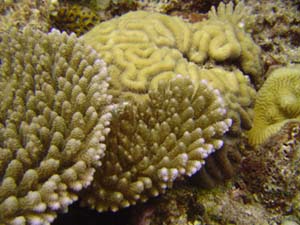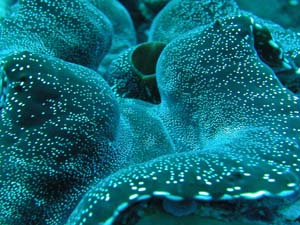1st Sept - 12th Sept, 2004

Barrier reef
23°C
2.7% of area studied shown to be affected by bleaching
There were no visible signs of disease.
25 meters vertically from the surface
1-2 observed per dive
Aitutaki consists of a main island surrounded by a large shallow lagoon enclosed by a barrier reef which has many motus (small islands) appearing above the water's surface. It has a population of approximately 1,500 - the population has decreased by a third in the last eight years. The majority live along the sandy coastline, with fewer people living inland. Both inland and on the south side of the island, there are wild coconut palms, privately owned gardens, farms and grazing fields. The lagoon is about 10 m at its deepest point with many bommies. The seven motus are used for daytrips and overnight stays by tourists and locals alike. There are nesting seabirds on some of them.
Inside the lagoon, we found a mixture of very healthy bommies and dead coral structures with algae overgrowth. Coral coverage on the bommies ranged from 10-80% and diversity varied. Bommies with extensive coral coverage had up to 17 coral genera. The corals under stress were primarily affected by sedimentation from the sandy bottom and silt running off from shore. Many corals were covered in a think layer of mucous, a defense reaction to keep sediment off their tissue.
The reef outside the lagoon also has high levels of diversity with 31 coral genera counted. Coral cover outside the lagoon rarely exceeded 40% and was scattered along volcanic ridges from 3-27 meters. The reef crest is shallow and local fishermen often walk along the reef structure at low tide. Shallow reef structure from 0-3 meters is made up of volcanic rock with little to no coral growth excluding an occasional small Pocillopora or Acropora colony. At 4 meters, the reef begins to extend out to sea and forms underwater outcrops separated by deep valleys with sandy bottoms. Corals were primarily healthy, with unhealthy corals being overgrown by filamentous algae. The majority of corals were small and did not exceed 50 cm in diameter, which is indicative of new growth.
The reef at Aitutaki, both inside and outside the lagoon is healthy and diverse, but for many of the local people, this was quite a surprise. We were told that not too long ago, the majority of the corals at Aitutaki were dead or dying, due to a variety of factors including crown of thorns outbreaks and fungicide use. In the 1970ís, bananas being exported to New Zealand were brought to the dock and washed in fungicides. If the cargo ship was late or did not arrive, and the bananas began to rot, they were dumped off the dock into the lagoon, fungicides and all. Many people on the island believe this played a major role in the degradation of the reef. Since Aitutaki has stopped exporting bananas, the reef has bounced back and is growing again. We were also informed of a major crown of thorns outbreak sometime in the 1980ís. The whole island shut down for a day, schools, businesses, etc. to go out into the lagoon and kill as many crown of thorns as they could. This improved the reef dramatically and today if a fisherman sees a crown of thorns, he will remove it from the reef and bring it to land to dry out and die. RV Heraclitus divers observed an occasional crown of thorns on the reef, but overall, the reef here is strong and has significantly recovered from previous states of poor health.

There are 4 giant clam reserves within the Aitutaki lagoon run by the local Ministry of Marine Resources. In the past, giant clams were abundant throughout the lagoon, but were heavily fished for food until the clam population was at a critical threshold. In 1991, the Ministy of Marine resources set up a giant clam reserve. The local variety of giant clams was found to grow incredibly slowly, and so it was decided to import two faster growing species of giant clams from Malaysia. All clams within the reserves are protected and are guarded by local fishermen and tourist operators. The reserves are a lot of work and require a lot of maintenance, but they are a big success. They are using wire cages to grow hundreds of clams. When they reach about 20cm they try to sell them to the international aquarium market. Divers of the RV Heraclitus saw at least one and as many as five giant clams on each dive, exemplifying the fact that the clam populations in Aitutaki are increasing once again.
The RV Heraclitus would like to thank Lawton and Richard Storey for all their time and help in showing us the lagoon of Aitutaki.